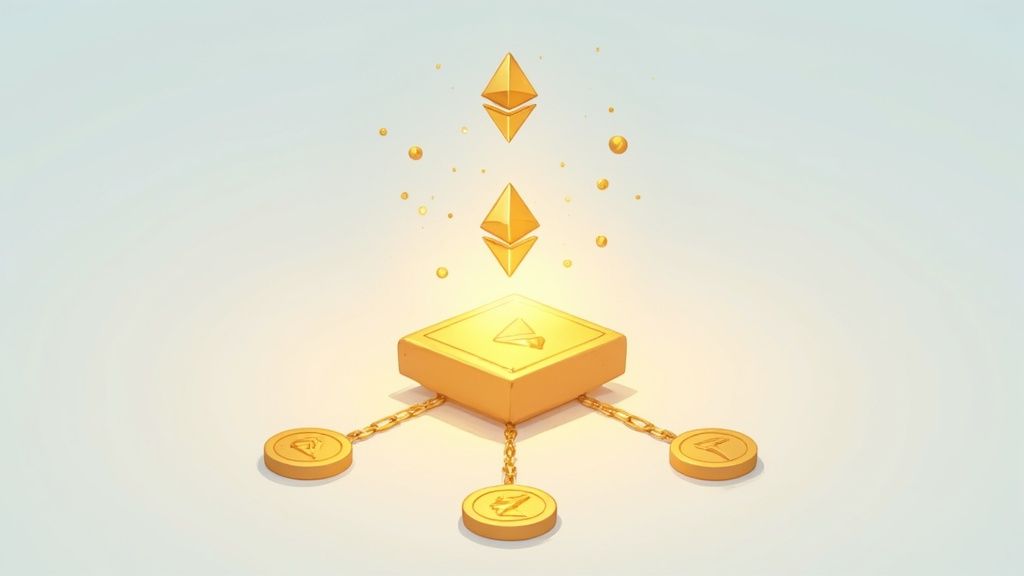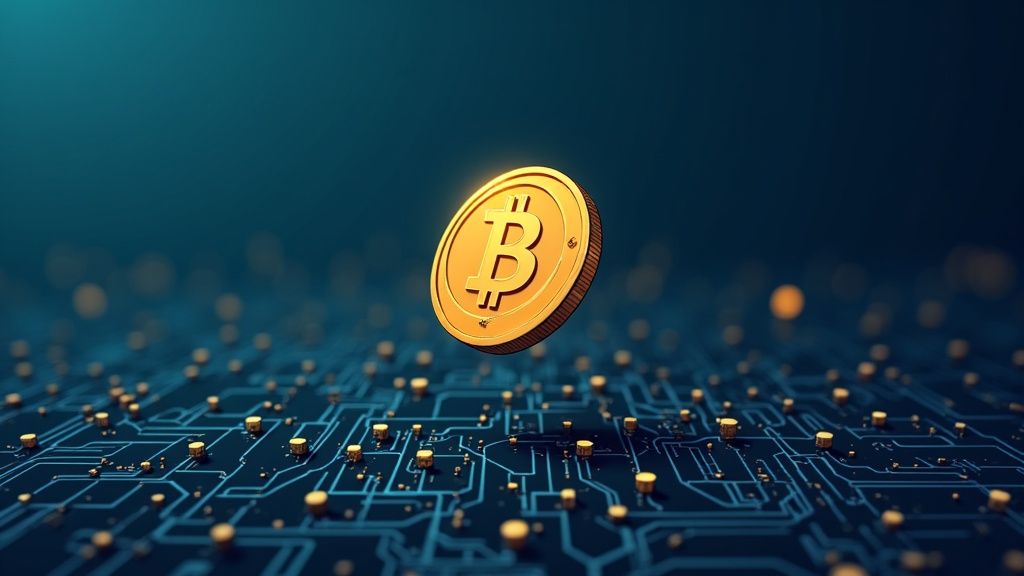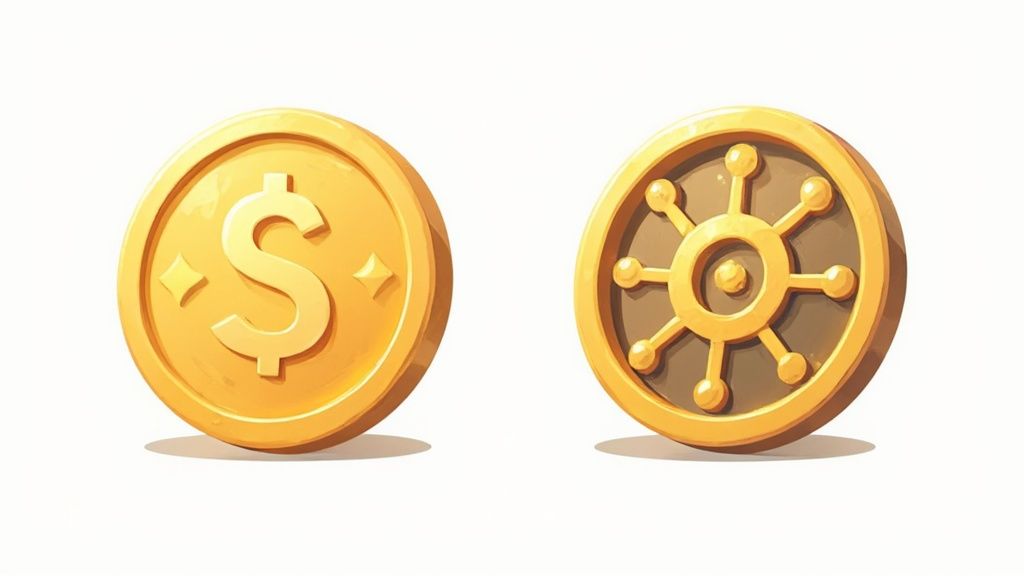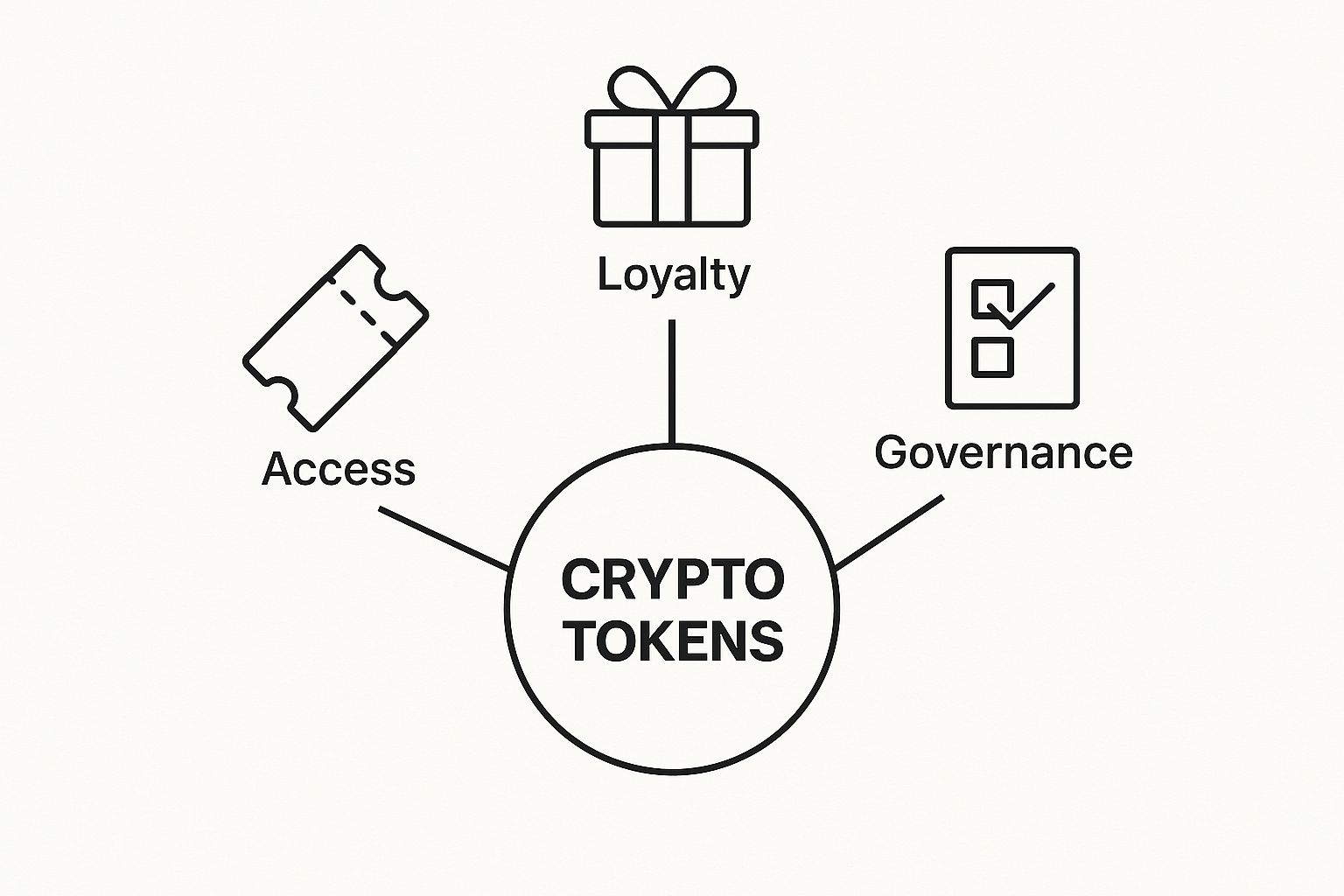What Is a Crypto Token Explained Simply

Alright, let's get straight to it. A crypto token isn't digital money in the same way Bitcoin is. Think of it more like a digital voucher, an arcade ticket, or even loyalty points for a specific company—but all living on the blockchain. It represents a certain value or grants you access to do something specific on an existing platform, like Ethereum.
Unpacking the Digital Building Blocks

Let's use an analogy. Imagine a big, bustling digital city like Ethereum. It's got all the essential infrastructure already built: roads, electricity, plumbing—the works. A crypto coin, like Ether (ETH), is the official currency of that city. You use it to pay for everything, from sending money to running applications.
Now, a crypto token is like a specialized ticket or pass that only works inside that city. One token might get you into an exclusive club (that's a utility token). Another could represent a share in a new business opening downtown (a security token). And yet another might be a one-of-a-kind ticket to a concert in the city square (an NFT).
See the difference? They all depend on the city's infrastructure to function, but each one has a unique job.
This is the key takeaway. Coins have their own independent blockchains, while tokens are built on top of blockchains that are already up and running. This "piggybacking" makes it way easier and faster to create a new token than it is to build an entire cryptocurrency from the ground up.
Crypto Token vs Crypto Coin at a Glance
For a quick summary, this table cuts through the noise and shows the core differences between a token and a coin.
| Feature | Crypto Coin (e.g., Bitcoin) | Crypto Token (e.g., UNI) |
|---|---|---|
| Foundation | Operates on its own native blockchain. | Built on an existing blockchain (e.g., Ethereum). |
| Primary Role | Acts as a store of value or medium of exchange. | Represents an asset, utility, or right to govern. |
| Creation | Involves creating a new blockchain, a complex process. | Relatively simple using smart contracts on platforms. |
| Analogy | The native currency of a country (e.g., USD). | A specific voucher for a service (e.g., gift card). |
So, a crypto token is a digital asset that stands for ownership or provides a specific function within a blockchain project. It's a different beast from cryptocurrencies like Bitcoin, which are mainly designed to be digital money.
The entire crypto market, which covers both coins and tokens, was valued at around USD 5.70 billion in 2024. It's not stopping there, either. Projections estimate it will climb to USD 11.71 billion by 2030, which just goes to show how important these digital assets are becoming. If you're curious, you can find more details on this market growth from Grand View Research.
A Look at the Different Types of Crypto Tokens

So, we've established that a crypto token is built on an existing blockchain. But what do they actually do? Well, not all tokens are created equal. They come in several distinct flavors, and each one has a specific job to do within the digital economy. Getting a handle on these categories is the key to understanding why tokens are so incredibly versatile.
It helps to think of them like different kinds of keys. You have a key to open your front door, another to start your car, and maybe one for a safe deposit box. In the same way, different tokens unlock different features, value, and functions within a crypto project's world.
Utility Tokens: The Access Keys
First up are utility tokens. These are probably the most common type you'll run into. Think of them as digital access passes or in-app credits. Their main job is to grant you access to a project's product or service. A great real-world analogy is an arcade—you can't play the games without buying their special arcade tokens first. That's a utility token in a nutshell.
It's important to remember they aren't really designed as investments. Their value comes from the "utility" they provide by letting you do things on a specific network.
- Filecoin (FIL): You use this token to pay for decentralized file storage on the Filecoin network.
- Basic Attention Token (BAT): In the Brave browser, you can earn BAT for viewing privacy-friendly ads and then use it to tip your favorite content creators.
Governance Tokens: The Voting Slips
Next, we have governance tokens. As the name suggests, these tokens give holders the right to vote on a project's future direction. They're basically voting slips for a decentralized organization, giving the community a real voice in important decisions.
This could be anything from voting on proposals for new features, making changes to the fee structure, or deciding how to spend funds in the project's treasury. Generally, the more tokens you hold, the more weight your vote carries. A classic example is Uniswap's UNI token, which lets its community vote on the future of the decentralized exchange.
Governance tokens are a massive step towards true decentralization. They shift power away from a small team of founders and hand it over to the actual users and stakeholders, which helps create a more democratic and resilient ecosystem.
Security Tokens: The Digital Shares
Now, security tokens are a completely different animal. These are digital contracts that represent ownership in some external, tradable asset, and they fall under federal security regulations. The easiest way to think of them is as the crypto version of traditional stocks or bonds.
Because they represent a stake in a real-world business—like company equity or a piece of real estate—they have to play by the rules and comply with strict regulations. This makes them a bit less common, but they create a fascinating bridge between the world of crypto and traditional finance.
Non-Fungible Tokens (NFTs): The Unique Collectibles
And finally, we have Non-Fungible Tokens (NFTs). The other tokens we've discussed are "fungible," meaning they're interchangeable. One dollar bill is the same as any other dollar bill. NFTs are the opposite. Each one is completely unique and can't be replaced.
An NFT is essentially a digital certificate of ownership and authenticity for a one-of-a-kind item. This could be a piece of digital art, a song, or a special sword in a video game. They use the blockchain to prove you own a specific digital asset, creating true, verifiable scarcity for digital items for the first time in history.
How Crypto Tokens Actually Work
Ever stumbled across terms like "ERC-20" or "ERC-721" and felt like you were reading a foreign language? You're definitely not alone. The secret to how tokens function is baked into these "token standards," which are basically shared blueprints that developers agree to follow on a specific blockchain.
A great way to think about it is like a universal plug adapter. Every token built using a standard like Ethereum’s ERC-20 follows the same set of rules. This means any wallet or exchange that supports that standard can immediately "talk" to it, hold it, and trade it without any extra work. It’s the technical magic that lets your crypto wallet hold thousands of different tokens all at once.
If we didn't have these common standards, every single new token would need a custom-built solution to work with anything. The whole ecosystem would be a messy, disconnected nightmare.
The Two Major Token Blueprints
To really get what a crypto token is, it helps to look at the two most popular standards on the Ethereum network. They’re built for completely different jobs—kind of like how a dollar bill and a one-of-a-kind concert ticket are both printed on paper but serve wildly different purposes.
ERC-20: The Interchangeable Standard: This is the blueprint for fungible tokens. "Fungible" just means each unit is identical and interchangeable with another. Think of it like a dollar—your dollar is worth the exact same as my dollar. This makes ERC-20 tokens perfect for creating digital currencies, handing out loyalty points, or distributing voting rights in a project.
ERC-721: The Unique Standard: On the flip side, we have the standard for non-fungible tokens (NFTs). Every single ERC-721 token is unique and carries a distinct ID that proves its individuality. This makes it the perfect technology for representing ownership of one-of-a-kind things, whether that’s a piece of digital art, a rare collectible, or a specific plot of virtual land.
This infographic really nails the core jobs these standards do, from giving you access to a service to letting you vote on a project's future.

It’s a great visual that shows how one piece of tech can power everything from event ticketing to decentralized governance.
The Big Idea: Token standards are the glue that holds the crypto world together. They're a shared language that ensures tokens from different creators can play nicely with each other, making them easy to store, trade, and use across countless apps.
These standards are also why wallet compatibility is so important. For instance, knowing how to add a new network to MetaMask is a key skill for anyone looking to manage different tokens across the many blockchains that rely on these blueprints. It's this shared foundation that makes the whole system click.
Real-World Examples of Crypto Tokens in Action
Alright, let's move past the theory. The real magic happens when you see how crypto tokens are actually solving problems out in the wild. They’re not just speculative blips on a screen; they’re becoming the functional gears in new digital systems, shaking up everything from finance to entertainment.
So, where are tokens making a real difference today? Let's look at a few examples that show just how practical and powerful they can be.
Powering a New Financial System
DeFi, or Decentralized Finance, is easily the biggest and most explosive use case for tokens right now. Think of it as a parallel financial world built on blockchains, running without the need for traditional banks. In this ecosystem, tokens are the lifeblood.
- Lending and Borrowing: On platforms like Aave, you can lend out your crypto to earn interest or borrow against it. There's no loan officer or bank—just smart contracts doing the work.
- Decentralized Exchanges (DEXs): Look at Uniswap. Its UNI token gives the community voting rights on how the exchange is run. We're talking about a platform that handles billions in trades with no central company pulling the strings.
This entire system is built on tokens that represent loans, liquidity, or even voting power. It’s a completely different way to think about finance, one that's more open and gives users more control.
By swapping out human gatekeepers for automated code, DeFi tokens hand the keys back to the users. It's a fundamental shift in who controls the money.
Changing the Game with Digital Ownership
The gaming world is another place where tokens are making huge waves, especially NFTs (Non-Fungible Tokens). For decades, if you bought a cool sword or a rare skin in a game, you never really owned it. It was stuck in that one game, and the developer could take it away.
NFTs completely flip that on its head. When an in-game item is represented by a unique token on the blockchain, the player has true, verifiable ownership. You can sell it, trade it, or maybe even use it in a different game someday. This has given rise to the "play-to-earn" model, where your time and skill in a game can translate into actual, real-world value.
Making Global Payments Faster and Cheaper
One of the most practical and widely used crypto tokens is the stablecoin. These are tokens specifically built to hold a steady value, usually by being pegged to a real-world currency like the US dollar. Essentially, they're digital dollars that run on a blockchain.
Because their value doesn't swing wildly, stablecoins are perfect for everyday payments, especially across borders. They skip the slow, costly international banking system entirely. And we're not talking small numbers here. USDT (Tether) regularly processes over $1 trillion a month in transaction volume, and USDC has seen monthly volumes climb as high as $3.29 trillion.
This isn't just an experiment; it's a core piece of today's financial plumbing used by millions around the globe. If you want to see just how big this has become, you can explore the data on global crypto adoption for yourself.
The sheer variety of token applications is what makes this space so interesting. Here's a quick look at how different industries are putting them to work.
Examples of Token Applications Across Industries
| Industry | Token Type Used | Example Use Case |
|---|---|---|
| Finance | Fungible (ERC-20) | Aave's aTokens: Represent a user's deposited funds in a lending pool, accruing interest in real-time. |
| Gaming | Non-Fungible (ERC-721) | Axie Infinity: In-game characters (Axies) are NFTs that players can own, battle, and trade. |
| Supply Chain | Fungible & NFT | VeChain (VET): Tracks goods from source to consumer, with NFTs representing unique products to verify authenticity. |
| Real Estate | Security Token (STO) | RealT: Sells fractional ownership of rental properties, allowing investors to buy tokenized shares and earn rental income. |
| Art & Collectibles | Non-Fungible (ERC-721) | Foundation: A marketplace where artists mint their digital artwork as unique NFTs, providing proof of ownership and authenticity. |
| Social Media | Fungible (ERC-20) | Reddit Community Points: Tokens like Moons or Bricks that reward users for quality contributions within specific subreddits. |
| Governance | Fungible (ERC-20) | MakerDAO (MKR): A governance token that gives holders voting rights on proposals that affect the Dai stablecoin ecosystem. |
As you can see, tokens are far more than one-trick ponies. They're flexible tools being customized to fit the unique needs of different fields, unlocking new business models and giving more power to individuals.
Understanding Tokenomics: What Gives a Token Its Value?
So, why does one crypto token skyrocket while another just... doesn't? The answer usually comes down to its tokenomics.
This isn't some complex, secret formula. It's simply a mashup of "token" and "economics," and it covers all the rules that make a specific digital asset tick. Think of it like looking under the hood of a car before you buy it—you want to know what powers it, how it's built, and if it's designed to last.
A token's price isn't just a random number floating in the digital ether. It’s the result of a carefully designed system that controls how it's made, handed out, and, most importantly, used. Once you get a feel for a few key elements, you can start to tell the difference between a project with real potential and one running on empty hype.
The Core Pillars of Tokenomics
Every token's economic design rests on three main pillars. Each one is a crucial piece of the puzzle that shapes its stability and long-term value.
Supply Dynamics: This is all about the numbers. How many tokens will ever exist? Is there a fixed maximum supply, like Bitcoin’s famous 21 million cap, which creates scarcity? Or will new tokens be created forever, potentially causing inflation? The total supply is a huge factor.
Token Utility: This is the big one: What can you actually do with it? A token needs a purpose. Does it let you vote on the project's future, pay for a service, or earn rewards? A token with a clear, in-demand job is always going to be more valuable than one that’s just a digital paperweight.
Distribution and Allocation: How did the tokens get into people's hands in the first place? Were they spread out fairly among the community, or did the founders and early investors keep a huge chunk for themselves? This initial handout, often done during a Token Generation Event (TGE), tells you a lot about who the project is really for. If you're curious about how that works, our guide on the meaning of a TGE in crypto breaks it all down.
A project's tokenomics is its economic blueprint. When it's done right, it lines up the goals of the developers, users, and investors, creating a healthy ecosystem where everyone is pulling in the same direction.
You can see how much this matters just by looking at the market. Tokens have a massive range in value, all based on their design and utility. Take Ethereum, the blockchain that made most of these tokens possible in the first place—it has a market cap of around $542.6 billion.
Then you have tokens like Tether (USDT) and Binance Coin (BNB), which are worth around $178-$179 billion each because they serve critical functions as a stablecoin and a utility token for a major exchange. You can always discover more insights about cryptocurrency valuations to see how solid tokenomics directly translates into real-world value.
So, How Do You Get and Secure Your First Crypto Tokens?
Alright, ready to dive in? Getting your hands on your first crypto tokens is actually pretty simple, but the real trick is learning how to do it safely right from the start. Your first stop on this journey is setting up a digital wallet—this is where your assets will live.
The first big choice you'll have to make is between a "hot" wallet and a "cold" wallet.
Hot wallets are basically software that's always connected to the internet. Think of them as your everyday spending wallet. They're super convenient for making quick trades and interacting with apps. Popular choices you'll see everywhere are browser extensions like MetaMask or mobile apps like Trust Wallet.
Cold wallets, on the other hand, are physical hardware devices that keep your crypto completely offline. This makes them way more secure against hackers and online threats. A cold wallet is like your personal vault; it's the gold standard for long-term HODLing and gives you serious peace of mind.
Setting Up and Staying Safe
Once your wallet is set up, it's time to get some tokens. The most common route is through a centralized exchange (CEX) like Coinbase or Binance, where you can easily buy tokens with regular money. Another way some projects get their tokens out there is by giving them away to community members through events called airdrops. We break down the whole process in our guide on how an airdrop works.
No matter how you get your tokens, your security is everything. Seriously.
Your private key is the master password to all your crypto. If you lose it, your funds are gone forever. If someone else gets it, they can take everything. Never share it with anyone, for any reason.
To navigate the token world without getting burned, make these habits second nature from day one:
- Protect Your Keys: When you set up a wallet, you'll get a "seed phrase" (usually 12-24 words). Write it down on paper and store it somewhere safe and offline—like, physically safe. Never, ever save it as a screenshot or a note on your computer.
- Beware of Scams: Get used to being skeptical. If someone messages you with a "giveaway" or an offer that seems too good to be true, it is. And nobody legitimate will ever ask for your private key or seed phrase.
- Use Bookmarks: Phishing sites that look exactly like the real thing are a huge problem. Save the correct URLs for your exchanges and wallet services as bookmarks and only use those to log in.
Answering Your Top Questions About Crypto Tokens
As you dive deeper into the crypto world, a few questions always seem to pop up. You’ve got the basics of what a token is, but some things might still feel a bit fuzzy. Let's tackle some of the most common ones I hear.
Getting these fundamentals straight is key. It helps you cut through the noise and navigate the space with a lot more confidence.
Are All Crypto Tokens a Good Investment?
Not even close. In fact, most of them aren't.
A token's value is almost entirely speculative. It’s tied to its actual use case (if it has one), the team behind the project, and the whims of the market. The hard truth is that many token projects fizzle out and fail completely.
This is why you'll see the phrase "Do Your Own Research" (DYOR) plastered everywhere. Before you even think about putting money into a token, you need to dig into its tokenomics and understand what the project is trying to achieve long-term. The golden rule always applies: Never invest more than you are prepared to lose.
Can I Make My Own Crypto Token?
Surprisingly, yes. Blockchains like Ethereum and Solana have made the technical side of creating a basic token pretty straightforward, especially with established standards like ERC-20. There are even tools that let you whip up a simple token in a few minutes.
But here’s the catch: creating a token is the easy part. Building a token with real utility, a sound economic model, and a genuine reason to exist? That’s incredibly hard. The code is just the first step; creating a valuable project around it takes serious expertise and a clear vision.
What Is the Main Difference Between a Token and an NFT?
It all boils down to one simple concept: fungibility.
A standard crypto token (like an ERC-20) is fungible. Think of it like a dollar bill. My dollar is worth the exact same as your dollar, and we can swap them without any change in value. They are identical and interchangeable.
An NFT (Non-Fungible Token) is, well, non-fungible. Each one is completely unique and has a distinct digital signature that proves it. It acts more like a deed to a house or the ticket to your specific seat at a concert—it represents ownership of one particular, one-of-a-kind item.
Ready to build a thriving Web3 community without the technical overhead? Domino helps you launch engaging, reward-based quests in minutes. Automate on-chain and off-chain tasks, from social shares to NFT staking, and watch your user base grow. See how you can accelerate your project's growth at domino.run.
Level Up Your dApps
Start using Domino in minutes. Use automations created by the others or build your own.
